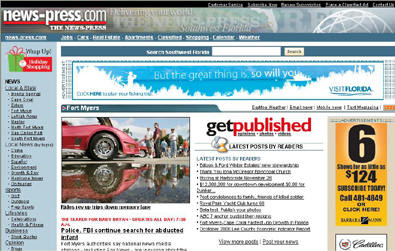Local newspapers target community beats online

Could this be the future of newspapering, asks Frank Ahrens. What is the “this” he is referring to?:
Ahrens' photo of Myron at work in his car on his community beat des not conjour up fabled notions of hard-nosed reporters pounding the city streets to uncover juicy metro scoops. (The photo is offered for sale by The Washington Post for $49.95).Chuck Myron is one of more than a dozen "mobile journalists" -- mojos -- for the Fort Myers News-Press. He doesn't have an office or even a cubicle, so his car is his newsroom.
Myron, long-haired and wearing a casual sweatshirt type top, is hunched behind the steering wheel. Ahrens portrays Myron’s routine:
Darkness falls on a chilly Winn-Dixie parking lot in a dodgy part of North Fort Myers just before Thanksgiving. Chuck Myron sits in his little gray Nissan and types on an IBM ThinkPad laptop plugged into the car's cigarette lighter. The glow of the screen illuminates his face.
The stories on Myron’s beat are similarly unglamorous:
The event he just covered? The signing of a fundraising calendar for the local chamber of commerce featuring the Hunks of North Fort Myers. The event was held inside a gym beside a Winn-Dixie in a strip shopping center.
It had been looking dim -- just three hunks and half a dozen seemingly uninterested middle-aged ladies working out nearby -- when Myron arrived at the gym with his ThinkPad under one arm and a digital camera peeking out of a pocket of his khakis.
Twenty minutes passed before one senior citizen and her husband walked in with two calendars to be signed by the hunks. She agreed to be interviewed and have her picture taken by Myron. He took notes on the screen of his ThinkPad, using an electronic stylus.
Thirty minutes later, sitting in his car with a sense of relief, he has written a short story, cropped one digital picture, written a caption, uploaded it all to the Web and linked to a previous story he'd written on the calendar fundraiser. Traditionally, such a story would barely rise to the level of a newspaper's weekly community insert. Yet this is the third story Myron has written on the calendar.
Myron’s beat may not be “sexy” compared to metro beats at big city national papers—such as Ahrens' Washington Post—but his “hyper-local” reporting may be just what the local newspaper doctor ordered.

Ahrens cites News-Press managing editor Mackenzie Warren, "Whatever you spend your time and money doing, is news" and writes:
Myron and his colleagues are part of a great experiment being conducted by their corporate parent, McLean-based newspaper giant Gannett, which is trying to remake the very definition of a newspaper. Losing readers and revenue to the Internet and other media, newspapers are struggling to stay relevant and even afloat. Gannett's answer is radical. The chain's papers are redirecting their newsrooms to focus on the Web first, paper second. Papers are slashing national and foreign coverage and beefing up "hyper-local," street-by-street news. They are creating reader-searchable databases on traffic flows and school class sizes. Web sites are fed with reader-generated content…In short, Gannett -- at its 90 papers, including USA Today -- is trying everything it can think of to create Web sites that will attract more readers.
The viability of local newspapers’ online operations was on the agenda last week at the Kelsey Local Interactive Media conference in Philadelphia, as I recount in “Can local newspapers win online?”:
How can local newspapers leverage their “trusted brands” online?...
Newspapers account for about 18% of the offline ad spend, or about $47 billion, but newspaper Websites only represent about 4% of the online ad spend.
For Shawn Riegsecker, CEO, Centro, the traditional local newspaper value proposition–reach and efficiency–has been usurped by online portals, notably Yahoo. He believes, however, that newspapers do have a rightful destiny online to capture more ad dollars from advertisers seeking to place their local messaging in trusted editorial and contextual environments.
Gannett is pursuing its rightful destiny one “mojo” at a time!